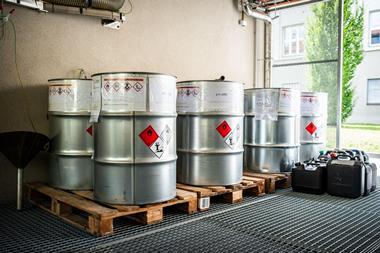Mary’s sulfur source
From Robert Close
In the article ‘Preserving the Mary Rose’, Jon Evans expresses surprise at the 2 tonnes of sulfur found in the ship’s hull.
This vessel and others of the fleet had guns, so there could have been a considerable quantity of gunpowder on the freshly provisioned ship, probably several tonnes. Black powder contains about 10% sulfur and the magazine would be deep in the hold; perhaps this was the source.
R Close CChem FRSC
Norwich, UK
Unusual isomerism
From Donald Cairns
I very much enjoyed the article ‘Targeting breast cancer’, although I am slightly disappointed that the author did not find space to comment on the interesting stereochemistry of tamoxifen.
This drug exhibits geometrical isomerism by virtue of reduced rotation around the C=C double bond. This isomerism is often described either by the cis/trans system (depending on whether functional groups are on the same or opposite sides of the double bond) or by the E/Z system based on the priority of functional groups using the Cahn–Ingold–Prelog convention, where priority is assigned according to the atomic numbers of substituents around the double bond.
In the vast majority of molecules, cis equates with Z while trans equates with E (in fact the terms are often used synonymously in the literature). However, tamoxifen is a notable example of a compound that is trans with respect to the phenyl groups but Z when the Cahn–Ingol–Prelog priorities are used.
D Cairns CChem FRSC
Robert Gordon University, UK
Fracking fallacy
From John Davis
I share Chris Rhodes’ concern that while shale gas from fracking may provide a temporary contribution to our energy supply, it may be less than some have been predicting.
Other downsides (such as disposal of the used fracking fluid, possible contamination of water supplies, etc) were aired at the Royal Society of Chemistry seminar last September. And of course shale gas is still a fossil fuel, generating CO2 on combustion.
Unfortunately there are several influential politicians who seemingly don’t understand the science, or are otherwise dismissive of the impact of discharging billions of tonnes of CO2 into our atmosphere (as in John Birtill’s letter). The danger then is that the recent drive to install renewable energy sources, such as wind turbines and solar, will be undermined by another ‘dash for gas’ – and here in the UK possibly not much of it.
J B Davis
Hertfordshire, UK
Orsat’s Aussie appreciation
From Clifford Jones
I read with interest the article about the Orsat gas analyser. I had to supervise this experiment in the undergraduate labs at the University of New South Wales (UNSW) in Australia from 1987–1995 and my understanding was that the device was still in widespread use at that time, for example at the BHP Billiton coking facility in the Illawarra. For all its simplicity the Orsat was, in inexperienced hands, fraught with difficulties, which included loss of reagent from one or more of the vessels.
In exposing the reagent to the gas being analysed, it is necessary to repeatedly raise the water-filled bottle connected to the apparatus well above the supporting frame. One cohort of UNSW students noted a similarity with raising a beer glass in salutation. Consequently, a group of them formed the ‘Orsat appreciation society’ and took themselves off once a week to a local pub where they would drink one another’s health in mimicry of the Orsat experiment. All innocent fun, though I will point out that I declined an invitation to be the staff representative in the society.
The article notes that variants of the Orsat apparatus are still in use. I always understood that the fact that it requires no electrical power has been seen as a major advantage.
J C Jones FRSC
University of Aberdeen, UK
Them and -ous
From Tony Addison
David Snodin’s query about the spelling ‘phosphorous’ struck a nerve over here. Particularly on web pages, one might read something like ‘Phosphorous is an interesting element because of it’s several allotropes’ (sic). I reckon the reason is just that there are a lot of people who can’t spell correctly. Older element-15 terminology is simply that ‘phosphorous’ refers to a phosphorus(iii) compound, and ‘phosphoric’ to a phosphorus(v) one. My colleagues and I find the avalanche of inappropriate apostrophes, as exemplified above, even more irritating.
T Addison FRSC
Drexel University, US
Title defence
From Alwyn Davies
I am the editor of the (former Royal Society of Chemistry) Journal of Chemical Research and I recently received an invitation to publish in a new journal called JChem Research. This title has the obvious possibility of causing confusion in referencing and indexing, in databases, in impact factors and in the minds of chemists.
Apparently, one unintended consequence of gold open access is the proliferation of publishers inviting papers, and charging a fee for publication, in new journals that often have a similar name to established journals. The subsequent refereeing and editing may then be of a questionable standard.
Following negotiations, the publisher has changed the title. This shows the importance of defending titles.
Colleagues I have spoken with were unaware of this innovation, which has the potential to damage the reputation of scientific research. This practice, and its dangers, needs to be widely publicised. We should all be wary of invitations to act on the editorial boards, or as referees, or to publish in journals the background of which is not transparent.
A G Davies FRSC
University College London, UK
Lazy gases
From Clive Delmonte
I was intrigued by Neil Dickinson’s letter and offer this possible explanation for his example of a ‘lazy gas’ such as trifluoronitrosomethane.
Perhaps the vapour produced initially consists of gaseous aggregates of the polar molecule he cites. Early condensation is rapid because these aggregates are re-forming as liquid.
When these gaseous aggregates were stored at reduced pressure, they may have dissociated towards a monomolecular gas. On condensing this gas, the process is slower because more condensation ‘events’ are necessary as the polar molecules assemble themselves in the liquid phase. Just a thought.
C Delmonte FRSC
Norfolk UK
From Huw Pritchard
The ‘lazy gas’ effect could be explained by a slow leak in the apparatus. Depending on how serious it was, and the bore and length of the connecting tubing, a change of a few milli-Torr would do it.
H Pritchard MRSC
York University, Canada
Graham Hills 1926–2014
From Laurence Peter
In February, Graham Hills, known as ‘GJ’ to many of his colleagues, passed away.
Hills’ early career took him from Westcliffe High School near Southend-on-Sea via Birkbeck College and Imperial College to the chair of physical chemistry at Southampton University in 1962, where he remained until 1980.
His 18 years at Southampton saw the expansion of the electrochemistry group to become a leading centre in Europe, attracting many visitors from overseas and remaining at the forefront of international research. His subsequent move to Strathclyde University came at a challenging time, when government cuts were beginning to bite deep into university budgets. Hills saw Strathclyde through this difficult phase and into an era of expansion that still continues. Knighted in 1988 for his services to education, Hills used his retirement to push for the establishment of a University of the Highlands and Islands, a cause dear to his heart.
As one of his PhD students, I grew to respect and like him as a ‘renaissance man’ with a deeply civilised nature, recognising the importance and richness of life outside the ivory tower. He had the knack of making you feel at ease while still challenging you with difficult, often philosophical, questions.
He created a unique atmosphere in which students felt part of the international upsurge of research in electrochemistry, and as a young research student, it was a great experience to sit in seminars with Ernest Yeager and John Randles in the audience – both spending sabbaticals at Southampton at the same time.
A man of action, Hills was a consummate politician with a clear vision and he taught me (and I suspect many of his other students and colleagues) how to deal with difficult and challenging issues. His powers of persuasion were formidable, but always exercised with extraordinary charm and grace, underpinned by an impish sense of humour. Many of his colleagues never quite understood quite why they finished up agreeing with whatever he was proposing.
I am sure that I speak on behalf of all of those who were his PhD students, postdocs and academic colleagues over the years when I say that ‘GJ’ will be remembered with fond affection as a formative influence on our lives. He will be greatly missed.
L Peter CChem FRSC
University of Bath, UK












No comments yet